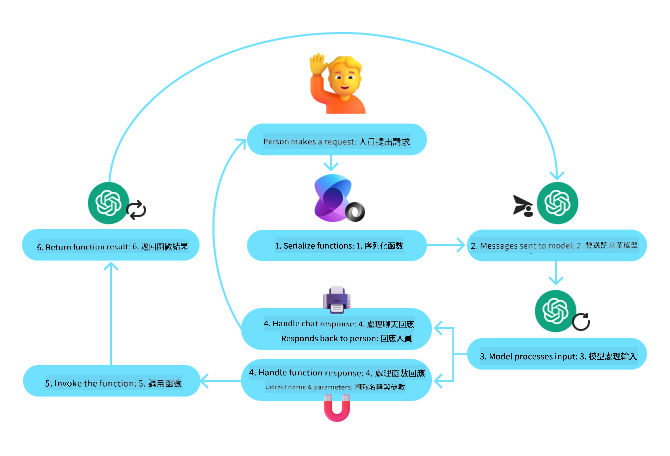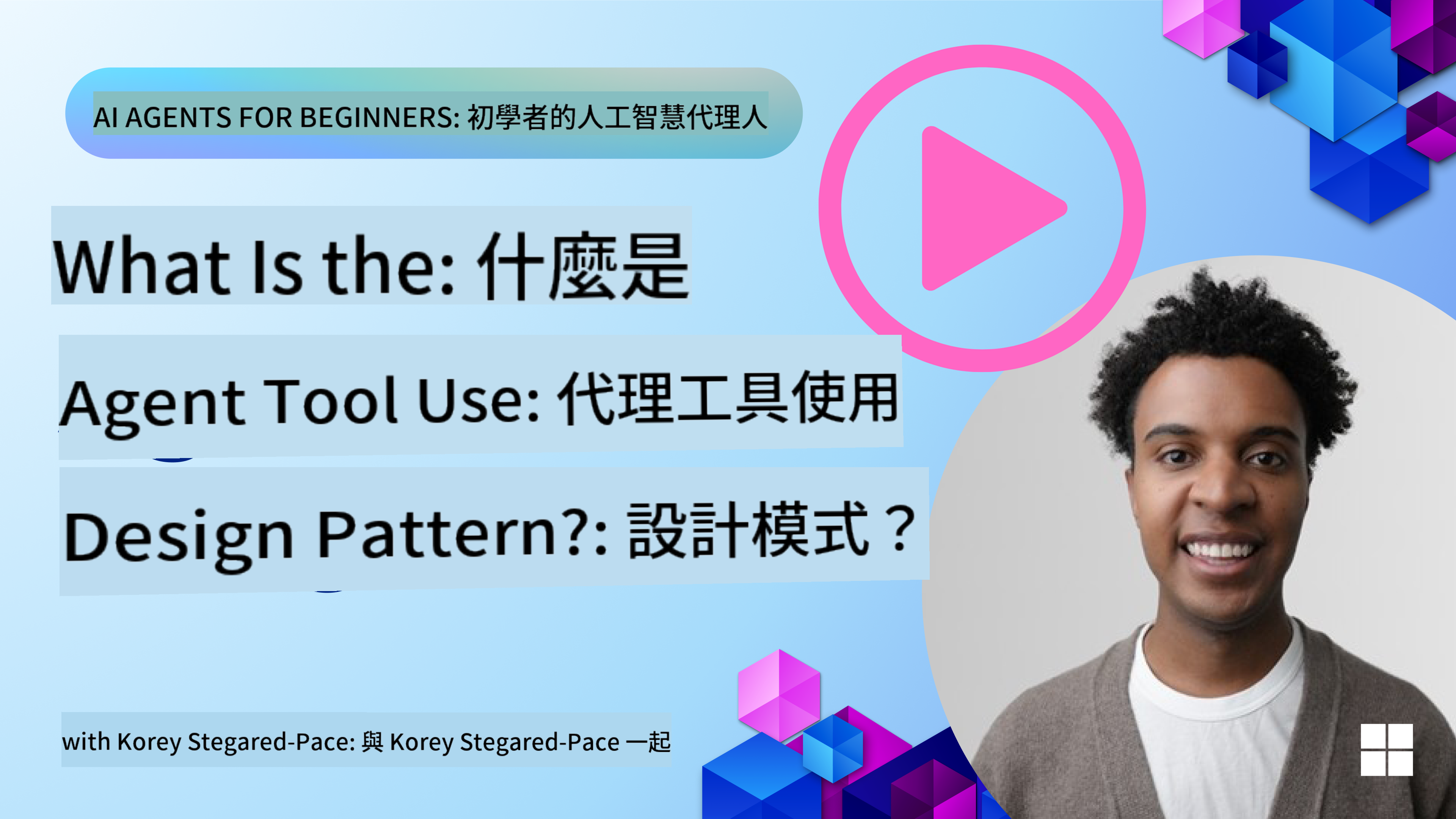ai-agents-for-beginners
(點擊上方圖片觀看本課程影片)
工具使用設計模式
工具之所以有趣,是因為它們能讓 AI 代理擁有更廣泛的能力。透過加入工具,代理不再僅限於執行有限的動作,而是能執行多種操作。在本章中,我們將探討工具使用設計模式,描述 AI 代理如何使用特定工具來達成目標。
簡介
在本課程中,我們希望回答以下問題:
- 什麼是工具使用設計模式?
- 它可以應用於哪些使用案例?
- 實現此設計模式需要哪些元素/基礎構件?
- 使用工具使用設計模式來構建值得信賴的 AI 代理需要注意哪些特別事項?
學習目標
完成本課程後,您將能夠:
- 定義工具使用設計模式及其目的。
- 辨識工具使用設計模式適用的使用案例。
- 理解實現此設計模式所需的關鍵元素。
- 認識使用此設計模式的 AI 代理在可信度方面的考量。
什麼是工具使用設計模式?
工具使用設計模式專注於賦予大型語言模型 (LLMs) 與外部工具互動的能力,以達成特定目標。工具是代理可執行的程式碼,例如計算器函數,或是第三方服務的 API 呼叫(如股票價格查詢或天氣預報)。在 AI 代理的背景下,工具設計為能由代理執行,以回應模型生成的函數呼叫。
它可以應用於哪些使用案例?
AI 代理可以利用工具完成複雜任務、檢索資訊或做出決策。工具使用設計模式通常用於需要與外部系統動態互動的場景,例如資料庫、網路服務或程式碼解釋器。此能力適用於多種使用案例,包括:
- 動態資訊檢索:代理可以查詢外部 API 或資料庫以獲取最新數據(例如查詢 SQLite 資料庫進行數據分析、獲取股票價格或天氣資訊)。
- 程式碼執行與解釋:代理可以執行程式碼或腳本以解決數學問題、生成報告或進行模擬。
- 工作流程自動化:透過整合工具如任務排程器、電子郵件服務或數據管道來自動化重複或多步驟的工作流程。
- 客戶支援:代理可以與 CRM 系統、工單平台或知識庫互動以解決用戶問題。
- 內容生成與編輯:代理可以利用工具如文法檢查器、文本摘要生成器或內容安全評估器來協助完成內容創作任務。
實現工具使用設計模式需要哪些元素/基礎構件?
這些基礎構件使 AI 代理能執行多種任務。以下是實現工具使用設計模式所需的關鍵元素:
- 函數/工具架構:詳細定義可用工具,包括函數名稱、用途、所需參數及預期輸出。這些架構使 LLM 能理解可用工具及如何構建有效請求。
- 函數執行邏輯:管理工具的調用方式及時機,基於用戶意圖及對話上下文。這可能包括規劃模組、路由機制或條件流程以動態決定工具使用。
- 消息處理系統:管理用戶輸入、LLM 回應、工具呼叫及工具輸出的對話流程的組件。
- 工具整合框架:連接代理與各種工具的基礎設施,無論是簡單函數還是複雜的外部服務。
- 錯誤處理與驗證:處理工具執行失敗、驗證參數及管理意外回應的機制。
- 狀態管理:追蹤對話上下文、先前工具互動及持久數據,以確保多輪交互的一致性。
接下來,我們將更詳細地探討函數/工具呼叫。
函數/工具呼叫
函數呼叫是讓大型語言模型 (LLMs) 與工具互動的主要方式。您會經常看到「函數」和「工具」交替使用,因為「函數」(可重用的程式碼塊)是代理用來執行任務的「工具」。為了調用函數的程式碼,LLM 必須將用戶的請求與函數的描述進行比對。為此,包含所有可用函數描述的架構會被傳送至 LLM。LLM 然後選擇最適合任務的函數並返回其名稱及參數。選定的函數被調用,其回應被傳回 LLM,LLM 使用該資訊回應用戶的請求。
開發者要為代理實現函數呼叫,需要:
- 支援函數呼叫的 LLM 模型
- 包含函數描述的架構
- 每個描述函數的程式碼
以下用獲取城市當前時間的例子來說明:
-
初始化支援函數呼叫的 LLM:
並非所有模型都支援函數呼叫,因此確認您使用的 LLM 是否支援此功能非常重要。Azure OpenAI 支援函數呼叫。我們可以從初始化 Azure OpenAI 客戶端開始。
# Initialize the Azure OpenAI client client = AzureOpenAI( azure_endpoint = os.getenv("AZURE_OPENAI_ENDPOINT"), api_key=os.getenv("AZURE_OPENAI_API_KEY"), api_version="2024-05-01-preview" ) -
建立函數架構:
接著我們將定義一個 JSON 架構,其中包含函數名稱、函數用途的描述,以及函數參數的名稱和描述。 然後將此架構與用戶請求(例如查詢舊金山的時間)一起傳送至先前建立的客戶端。需要注意的是,返回的是工具呼叫,而不是問題的最終答案。如前所述,LLM 返回其為任務選擇的函數名稱及將傳遞給它的參數。
# Function description for the model to read tools = [ { "type": "function", "function": { "name": "get_current_time", "description": "Get the current time in a given location", "parameters": { "type": "object", "properties": { "location": { "type": "string", "description": "The city name, e.g. San Francisco", }, }, "required": ["location"], }, } } ]# Initial user message messages = [{"role": "user", "content": "What's the current time in San Francisco"}] # First API call: Ask the model to use the function response = client.chat.completions.create( model=deployment_name, messages=messages, tools=tools, tool_choice="auto", ) # Process the model's response response_message = response.choices[0].message messages.append(response_message) print("Model's response:") print(response_message)Model's response: ChatCompletionMessage(content=None, role='assistant', function_call=None, tool_calls=[ChatCompletionMessageToolCall(id='call_pOsKdUlqvdyttYB67MOj434b', function=Function(arguments='{"location":"San Francisco"}', name='get_current_time'), type='function')]) -
執行任務所需的函數程式碼:
現在 LLM 已選擇需要執行的函數,接下來需要實現並執行完成任務的程式碼。 我們可以用 Python 實現獲取當前時間的程式碼。我們還需要撰寫程式碼以從 response_message 中提取名稱及參數以獲得最終結果。
def get_current_time(location): """Get the current time for a given location""" print(f"get_current_time called with location: {location}") location_lower = location.lower() for key, timezone in TIMEZONE_DATA.items(): if key in location_lower: print(f"Timezone found for {key}") current_time = datetime.now(ZoneInfo(timezone)).strftime("%I:%M %p") return json.dumps({ "location": location, "current_time": current_time }) print(f"No timezone data found for {location_lower}") return json.dumps({"location": location, "current_time": "unknown"})# Handle function calls if response_message.tool_calls: for tool_call in response_message.tool_calls: if tool_call.function.name == "get_current_time": function_args = json.loads(tool_call.function.arguments) time_response = get_current_time( location=function_args.get("location") ) messages.append({ "tool_call_id": tool_call.id, "role": "tool", "name": "get_current_time", "content": time_response, }) else: print("No tool calls were made by the model.") # Second API call: Get the final response from the model final_response = client.chat.completions.create( model=deployment_name, messages=messages, ) return final_response.choices[0].message.contentget_current_time called with location: San Francisco Timezone found for san francisco The current time in San Francisco is 09:24 AM.
函數呼叫是大多數代理工具使用設計的核心,然而從零開始實現它有時可能具有挑戰性。 正如我們在第 2 課中所學,代理框架提供了預建的基礎構件來實現工具使用。
使用代理框架的工具使用範例
以下是使用不同代理框架實現工具使用設計模式的一些範例:
Semantic Kernel
Semantic Kernel 是一個開源的 AI 框架,適用於使用大型語言模型 (LLMs) 的 .NET、Python 和 Java 開發者。它透過一個稱為序列化的過程,簡化了函數呼叫的使用,能自動向模型描述您的函數及其參數。它還處理模型與程式碼之間的來回溝通。使用像 Semantic Kernel 這樣的代理框架的另一個優勢是,它允許您存取預建工具,例如文件搜尋和程式碼解釋器。
以下圖表說明了使用 Semantic Kernel 進行函數呼叫的過程:

在 Semantic Kernel 中,函數/工具被稱為插件。我們可以將之前看到的 get_current_time 函數轉換為插件,方法是將其轉換為包含該函數的類別。我們還可以匯入 kernel_function 裝飾器,該裝飾器接收函數的描述。當您使用 GetCurrentTimePlugin 創建內核時,內核會自動序列化函數及其參數,並在此過程中創建要傳送至 LLM 的架構。
from semantic_kernel.functions import kernel_function
class GetCurrentTimePlugin:
async def __init__(self, location):
self.location = location
@kernel_function(
description="Get the current time for a given location"
)
def get_current_time(location: str = ""):
...
from semantic_kernel import Kernel
# Create the kernel
kernel = Kernel()
# Create the plugin
get_current_time_plugin = GetCurrentTimePlugin(location)
# Add the plugin to the kernel
kernel.add_plugin(get_current_time_plugin)
Azure AI Agent Service
Azure AI Agent Service 是一個較新的代理框架,旨在幫助開發者安全地構建、部署及擴展高品質且可擴展的 AI 代理,而無需管理底層的計算及存儲資源。它特別適合企業應用,因為它是一個完全托管的服務,具有企業級安全性。
與直接使用 LLM API 開發相比,Azure AI Agent Service 提供了一些優勢,包括:
- 自動工具呼叫——無需解析工具呼叫、調用工具及處理回應;所有這些現在都在伺服器端完成。
- 安全管理數據——您可以依賴線程存儲所需的所有資訊,而無需自己管理對話狀態。
- 現成工具——可用於與數據源互動的工具,例如 Bing、Azure AI 搜索及 Azure 函數。
Azure AI Agent Service 中的工具可分為兩類:
- 知識工具:
- 行動工具:
Agent Service 允許我們將這些工具一起使用作為 toolset。它還利用 threads 來追蹤特定對話的消息歷史。
假設您是 Contoso 公司的一名銷售代理,您希望開發一個能回答銷售數據問題的對話代理。
以下圖片說明了如何使用 Azure AI Agent Service 分析您的銷售數據:

要使用服務中的任何工具,我們可以創建一個客戶端並定義工具或工具集。實際實現時,我們可以使用以下 Python 程式碼。LLM 將能查看工具集並根據用戶請求決定使用用戶創建的函數 fetch_sales_data_using_sqlite_query 或預建的程式碼解釋器。
import os
from azure.ai.projects import AIProjectClient
from azure.identity import DefaultAzureCredential
from fetch_sales_data_functions import fetch_sales_data_using_sqlite_query # fetch_sales_data_using_sqlite_query function which can be found in a fetch_sales_data_functions.py file.
from azure.ai.projects.models import ToolSet, FunctionTool, CodeInterpreterTool
project_client = AIProjectClient.from_connection_string(
credential=DefaultAzureCredential(),
conn_str=os.environ["PROJECT_CONNECTION_STRING"],
)
# Initialize function calling agent with the fetch_sales_data_using_sqlite_query function and adding it to the toolset
fetch_data_function = FunctionTool(fetch_sales_data_using_sqlite_query)
toolset = ToolSet()
toolset.add(fetch_data_function)
# Initialize Code Interpreter tool and adding it to the toolset.
code_interpreter = code_interpreter = CodeInterpreterTool()
toolset = ToolSet()
toolset.add(code_interpreter)
agent = project_client.agents.create_agent(
model="gpt-4o-mini", name="my-agent", instructions="You are helpful agent",
toolset=toolset
)
使用工具使用設計模式構建值得信賴的 AI 代理需要注意哪些特別事項?
LLM 動態生成的 SQL 常見的安全問題是 SQL 注入或惡意操作(例如刪除或篡改資料庫)的風險。雖然這些問題確實存在,但可以透過正確配置資料庫訪問權限有效減輕。對於大多數資料庫,這涉及將資料庫配置為只讀。對於像 PostgreSQL 或 Azure SQL 這樣的資料庫服務,應為應用程式分配只讀(SELECT)角色。 在安全環境中執行應用程式可以進一步提升保護。在企業場景中,通常會將資料從操作系統中提取並轉換到一個唯讀的資料庫或資料倉儲,並使用易於理解的結構。這種方法確保了資料的安全性,並且在效能和可存取性方面進行了優化,同時限制應用程式的唯讀存取。
範例程式碼
- Python: Agent Framework
- .NET: Agent Framework
對工具使用設計模式有更多疑問?
加入 Azure AI Foundry Discord,與其他學習者交流,參加辦公時間,並解答您對 AI Agents 的問題。
其他資源
- Azure AI Agents Service Workshop
- Contoso Creative Writer Multi-Agent Workshop
- Semantic Kernel Function Calling Tutorial
- Semantic Kernel Code Interpreter
- Autogen Tools
上一課
下一課
免責聲明:
本文件使用 AI 翻譯服務 Co-op Translator 進行翻譯。我們致力於提供準確的翻譯,但請注意,自動翻譯可能包含錯誤或不準確之處。應以原文文件作為權威來源。對於關鍵資訊,建議尋求專業人工翻譯。我們對因使用本翻譯而產生的任何誤解或誤釋不承擔責任。
